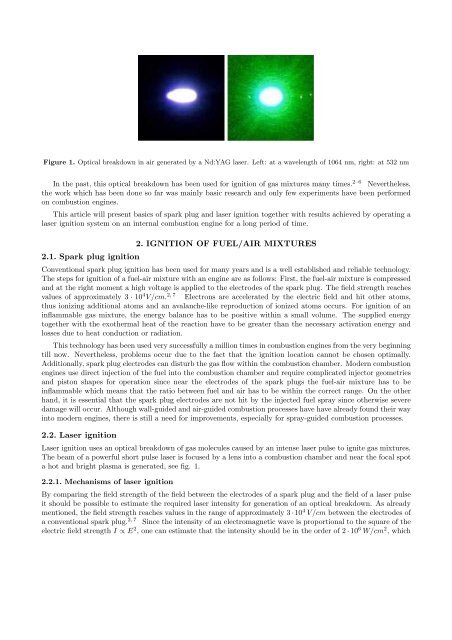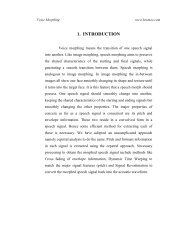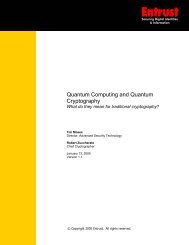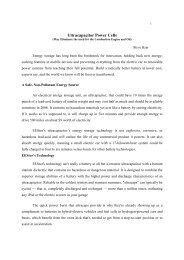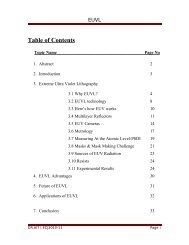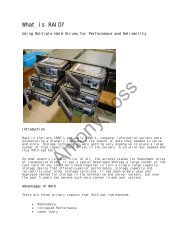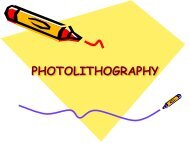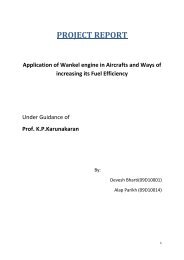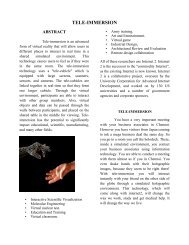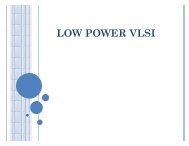Laser induced ignition of gasoline direct injection engines
Laser induced ignition of gasoline direct injection engines
Laser induced ignition of gasoline direct injection engines
Create successful ePaper yourself
Turn your PDF publications into a flip-book with our unique Google optimized e-Paper software.
Figure 1. Optical breakdown in air generated by a Nd:YAG laser. Left: at a wavelength <strong>of</strong> 1064 nm, right: at 532 nm<br />
In the past, this optical breakdown has been used for <strong>ignition</strong> <strong>of</strong> gas mixtures many times. 2–6 Nevertheless,<br />
the work which has been done so far was mainly basic research and only few experiments have been performed<br />
on combustion <strong>engines</strong>.<br />
This article will present basics <strong>of</strong> spark plug and laser <strong>ignition</strong> together with results achieved by operating a<br />
laser <strong>ignition</strong> system on an internal combustion engine for a long period <strong>of</strong> time.<br />
2. IGNITION OF FUEL/AIR MIXTURES<br />
2.1. Spark plug <strong>ignition</strong><br />
Conventional spark plug <strong>ignition</strong> has been used for many years and is a well established and reliable technology.<br />
The steps for <strong>ignition</strong> <strong>of</strong> a fuel-air mixture with an engine are as follows: First, the fuel-air mixture is compressed<br />
and at the right moment a high voltage is applied to the electrodes <strong>of</strong> the spark plug. The field strength reaches<br />
values <strong>of</strong> approximately 3 · 104V/cm. 2, 7 Electrons are accelerated by the electric field and hit other atoms,<br />
thus ionizing additional atoms and an avalanche-like reproduction <strong>of</strong> ionized atoms occurs. For <strong>ignition</strong> <strong>of</strong> an<br />
inflammable gas mixture, the energy balance has to be positive within a small volume. The supplied energy<br />
together with the exothermal heat <strong>of</strong> the reaction have to be greater than the necessary activation energy and<br />
losses due to heat conduction or radiation.<br />
This technology has been used very successfully a million times in combustion <strong>engines</strong> from the very beginning<br />
till now. Nevertheless, problems occur due to the fact that the <strong>ignition</strong> location cannot be chosen optimally.<br />
Additionally, spark plug electrodes can disturb the gas flow within the combustion chamber. Modern combustion<br />
<strong>engines</strong> use <strong>direct</strong> <strong>injection</strong> <strong>of</strong> the fuel into the combustion chamber and require complicated injector geometries<br />
and piston shapes for operation since near the electrodes <strong>of</strong> the spark plugs the fuel-air mixture has to be<br />
inflammable which means that the ratio between fuel and air has to be within the correct range. On the other<br />
hand, it is essential that the spark plug electrodes are not hit by the injected fuel spray since otherwise severe<br />
damage will occur. Although wall-guided and air-guided combustion processes have have already found their way<br />
into modern <strong>engines</strong>, there is still a need for improvements, especially for spray-guided combustion processes.<br />
2.2. <strong>Laser</strong> <strong>ignition</strong><br />
<strong>Laser</strong> <strong>ignition</strong> uses an optical breakdown <strong>of</strong> gas molecules caused by an intense laser pulse to ignite gas mixtures.<br />
The beam <strong>of</strong> a powerful short pulse laser is focused by a lens into a combustion chamber and near the focal spot<br />
a hot and bright plasma is generated, see fig. 1.<br />
2.2.1. Mechanisms <strong>of</strong> laser <strong>ignition</strong><br />
By comparing the field strength <strong>of</strong> the field between the electrodes <strong>of</strong> a spark plug and the field <strong>of</strong> a laser pulse<br />
it should be possible to estimate the required laser intensity for generation <strong>of</strong> an optical breakdown. As already<br />
mentioned, the field strength reaches values in the range <strong>of</strong> approximately 3 · 104 V/cmbetween the electrodes <strong>of</strong><br />
a conventional spark plug. 2, 7 Since the intensity <strong>of</strong> an electromagnetic wave is proportional to the square <strong>of</strong> the<br />
electric field strength I ∝ E2 , one can estimate that the intensity should be in the order <strong>of</strong> 2 · 106 W/cm2 ,which


